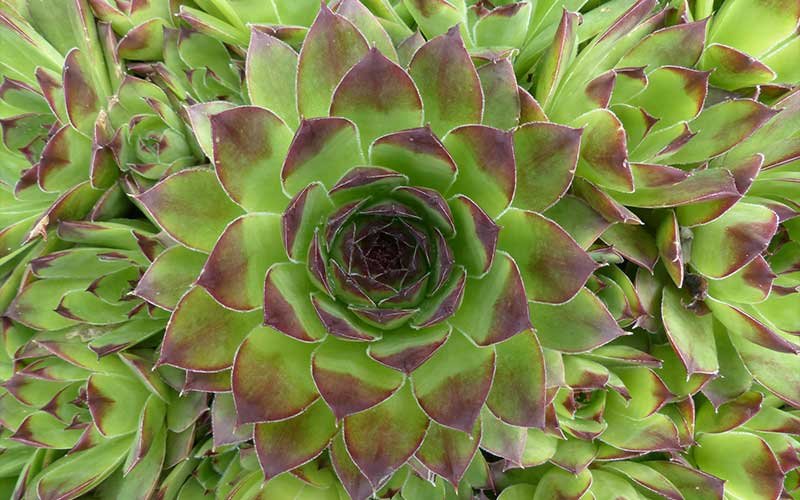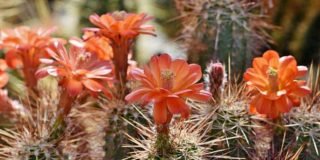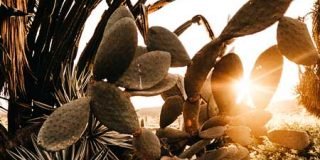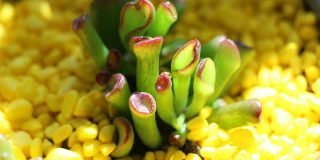Contents
Eternal Plants
Houseleeks are members of the group of Sempervivum of the family Crassulaceae. Sempervivum comes from the Latin words Semper and vivus meaning “forever living”. The common name houseleek is believed to have originated from the traditional practice of growing these plants on the roof of houses to deflect lightning and protect the home dwellers from the storm and other evil things.
This idea was inspired by the Roman god Jupiter, who regarded the plant as sacred. Now, people sometimes grow houseleeks on their roofs for added warmth and to prevent their thatched roofs from quickly burning. You can find many of this variety being sold all over the USA and Canada.
These succulents are sometimes referred to as hen and chicks, which may be due to the way these succulents produce their offsets. The rosettes (hen) will produce offshoots (chicks), and when left alone, they will gradually spread into extensive mats.
Houseleeks are generally outdoor succulents that thrive in cold months, but they are incredibly resilient, so they can also survive indoors in warmer temperatures. They resemble unfurled roses and come in a variety of form, texture, and colour. Their leaves have light pink to red-purple hues. They are low-growing, but some mature plants may bloom in the summer.
Blooms
The flowers of houseleeks usually bloom in the long and bright warm days of summer. The star-like, tiny flowers grow in clusters and come in red, pink, white, and yellow, with erect stamens. The flowers are said to resemble the beard of the Roman god, Jupiter.
When houseleeks are ready to produce flowers, the rosettes will begin to elongate vertically, making them look different from their typical low-growing stature. The flower stalks can grow from a few inches to a foot tall.
A flowering houseleek can be a bittersweet scenario for some growers, as it signals the end of the plant’s life cycle. Houseleeks are monocarpic succulents, which means they die after flowering and producing seeds. The seeds that the flowers produce will grow into new rosettes and fill in the place of its parent plant. Houseleeks usually live for three years before flowering, so you have a long time to enjoy your plant before it dies.

The flowers of houseleeks don’t need extra care. In fact, it will be best to leave them alone until they fully bloom, wither, and die. Once the flowers have dried out, clip it off the stem using this pruning shears instead of pulling them out so you can avoid accidentally yanking the offshoots out. You can also let nature take its course and allow the dying stem to break off and compost in the soil.
Nothing can be done to prevent houseleeks from producing flowers, not even cutting off its budding stem. So, enjoy your flowering succulents while they last, and welcome the smaller rosettes that will soon replace the parent plants.
Health Benefits
The use of houseleeks as herbal medicine dates back to ancient times. Houseleek has anti-inflammatory properties, and modern medicine confirms that it contains flavonoids, carbohydrates, and essential acids that are beneficial to human health.
Houseleeks are also known to treat skin problems. Using houseleek on the skin is similar to using aloe vera, and is considered as a safe, natural remedy because it almost doesn’t have any side effects. Juice the leaves of the plant and apply it on the affected skin. Houseleeks can treat burns, insect bites, frostbite, redness, swelling, scratches, wounds, and other skin inflammations.
Since the time of our ancestors, houseleeks have been used to treat ear infection and repair hearing loss and damages. Huge buildup of earwax can cause an ear infection. While the function of earwax is to protect the ear canal from diseases and assist in lubricating the ears, excessive accumulation can press against the eardrum and lead to hearing loss. The juice from houseleek can dissolve cerumen and relieve ear pain. Squeeze out some juice from the leaves of the plant and put a few drops in your ear.
The juice of houseleek is proven to contain polysaccharides and other antibacterial ingredients that protect the immune system. Freshly-squeezed juice from houseleeks is effective in curing disorder in the nervous system, unrealistic fears, and falling sickness. The juice is also useful in removing warts, lightening sun spots, relieving insect bites, and treating open wounds.
Mixing honey and houseleek juice makes it an effective cure for soreness, mouth ulcer, and bronchitis. Mixing the juice with honey and warm water will also help in bringing down a fever.

- Add 12 grams of fresh leaves into four litres of water
- Cook for 15 minutes
- Strain and leave to cool down
How to Care for a Houseleek
Houseleeks are easy to care for, so they are the perfect succulents to grow for beginners.
Watering
Houseleeks are perfect to plant in rocky soils. They are drought-tolerant, so they don’t require much water. Once they’re established, wait for the soil to dry out before you water your plants. If the temperature is hot where you live, you may need to water your houseleeks more frequently. Increase watering in summer, and refrain from watering in the colder months.
Temperature
For houseleeks to survive, they need an environment with a temperature ranging from 65 and 75 degrees F, but they are cold hardy so they can withstand temperatures as low as -30F. However, they go dormant during winter months and resume growing in spring. If you need to take them inside your home or office, make sure they get adequate light by placing them near a bright window.
Fertilizing
Houseleeks can grow well in poor soil, so there’s little need for fertilizer. However, if your plant is in a container, they might require some fertilizing. Fertilize your houseleeks during the growing season using a diluted liquid fertilizer, like this succulent plant food.
Common Problems

As mentioned earlier, houseleeks are very resilient succulents. They are generally resistant to plant diseases. The most common problem to growing houseleeks arises from poor handling.
Overwatering is probably one of the top problems you’ll encounter with your houseleeks. Too much water can cause the leaves to droop. Houseleeks are also prone to root rot and fungus, especially during the colder months. It’s therefore essential for your plants to have proper drainage and be planted in fast-draining soil. We recommend this organic succulent soil from Hoffman. It provides the drainage that your houseleeks need to thrive. Make sure to water your houseleeks when the soil is completely dried up.
Do not expose your houseleek to full sun to avoid sunburn. Move them to the shade to protect them from the afternoon sun, especially during the summer.
Houseleeks are not very prone to insect diseases, but they can attract larger critters in the spring — no need to worry though, as the damaged foliage will grow back on their own.
Houseleeks don’t need much of your effort and attention. They thrive on neglect. They’re easy to care for, even when it’s your first time to grow succulents.
If you’re planning to grow your houseleeks, make sure to check the links of the products we have recommended. They will come in handy when you start growing your plants. Even if you don’t have a green thumb, don’t worry! With the information we gave above, we’re sure you’ll do a great job taking care of your houseleeks.
TABOR TOOLS Pruning Shears
Miracle-Gro Liquid Succulent Plant Food
- Instantly feeds succulent plants, including cacti
- For all cacti, jade, aloe and other popular succulents
- Feeds instantly
- Able to apply directly to the soil or can mix with water
Hoffman 10404 Organic Cactus and Succulent Soil Mix
- Organic cactus and succulent soil mix
- Professionally formulated for use with both jungle and desert cacti
- Provides the drainage cacti need to flourish; ready to use; pH balanced












